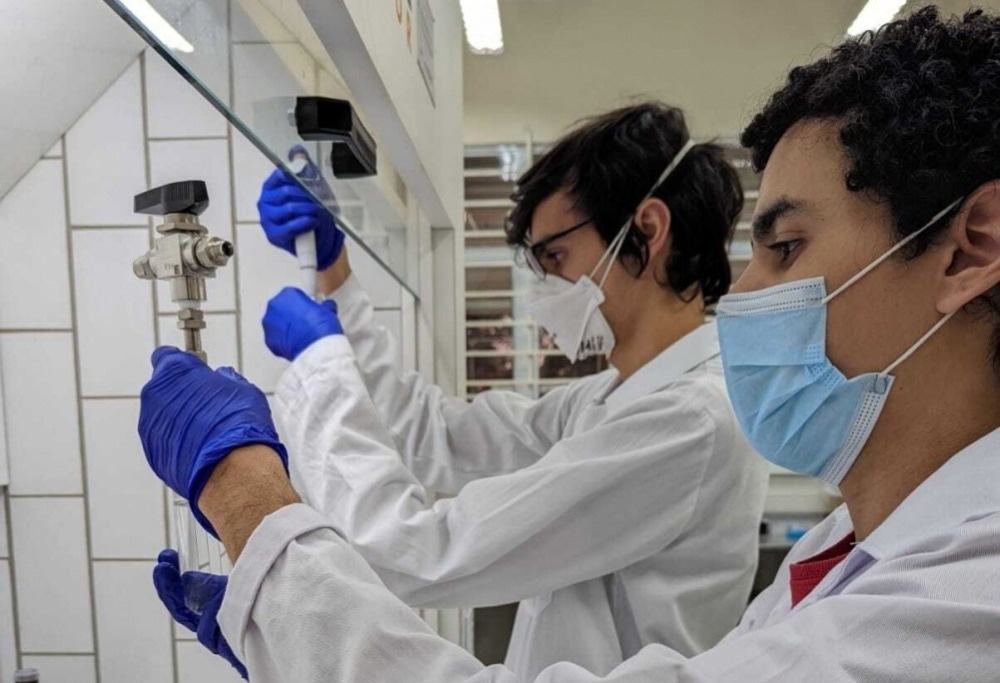Scientists have successfully converted methane into methanol using light and dispersed transition metals like copper through a process called photo-oxidation.
 The strategy was tested at the Federal University of São Carlos. The conversion took place under ambient temperature and pressure conditions, which could enable methane, a potent greenhouse gas, to be used to produce fuel. The process currently used by the chemical industry consumes large amounts of energy. Image Credit: researchers’ archive.
The strategy was tested at the Federal University of São Carlos. The conversion took place under ambient temperature and pressure conditions, which could enable methane, a potent greenhouse gas, to be used to produce fuel. The process currently used by the chemical industry consumes large amounts of energy. Image Credit: researchers’ archive.
The reaction was the greatest one yet for converting methane gas into liquid fuel under ambient settings of temperature and pressure (25 °C and 1 bar, respectively). The study was published in the journal Chemical Communications.
The Greek word for weight (baros) is where the word “bar” as a unit of pressure originates. The typical atmospheric pressure at sea level is extremely close to one bar (100 kPa), or 100,000 Pascals (101,325 Pa).
The study’s findings are a crucial step toward making natural gas available as a source of energy for the creation of substitutes for gasoline and diesel. Even though it is a fossil fuel, natural gas produces less carbon dioxide (CO2) when it is converted to methanol than other liquid fuels in the same class.
Methanol is an essential component of the chemical industry in Brazil, which uses it to synthesize a variety of goods, and for manufacturing biodiesel.
Methane has a 25 times greater capacity to contribute to global warming than CO2, for example, making its removal from the atmosphere essential for reducing the negative effects of climate change.
There’s a great debate in the scientific community about the size of the planet’s methane reserves. According to some estimates, they may have double the energy potential of all other fossil fuels combined. In the transition to renewables, we’ll have to tap into all this methane at some point.
Marcos da Silva, Study First Author, and PhD Candidate, Department of Physics, Federal University of São Carlos
The study was aided by FAPESP via two projects (20/14741-6 and 21/11162-8), by the Higher Research Council (CAPES, an agency of the Ministry of Education), and by the National Council for Scientific and Technological Development (CNPq, an arm of the Ministry of Science, Technology and Innovation).
The photocatalyst utilized in the study was a significant invention, according to Silva’s thesis advisor and last author, UFSCar professor Ivo Freitas Teixeira.
Our group innovated significantly by oxidizing methane in a single stage. In the chemical industry, this conversion occurs via the production of hydrogen and CO2 in at least two stages and under very high temperature and pressure conditions. Our success in obtaining methanol under mild conditions, while also expending less energy, is a major step forward.
Ivo Freitas Teixeira, Professor, Federal University of São Carlos
Teixeira claims that the findings open the door for future investigation into the use of solar energy for this conversion process, potentially lowering the operation’s environmental effect even more.
Photocatalysts
To create active visible-light photocatalysts, researchers created crystalline carbon nitride in the form of polyheptazine imide (PHI) in the lab utilizing transition metals that are neither noble nor abundant on earth, particularly copper.
Then, using hydrogen peroxide as an initiator, they employed the photocatalysts in methane oxidation processes. A significant amount of oxygenated liquid products, particularly methanol (2,900 micromoles per gram of material, or µmol.g-1 in 4 hours), were produced by the copper-PHI catalyst.
We discovered the best catalyst and other conditions essential to the chemical reaction, such as using a large amount of water and only a small amount of hydrogen peroxide, which is an oxidizing agent. The next steps include understanding more about the active copper sites in the material and their role in the reaction.
Ivo Freitas Teixeira, Professor, Federal University of São Carlos
Teixeira adds, “We also plan to use oxygen directly to produce hydrogen peroxide in the reaction itself. If successful, this should make the process even safer and economically viable.”
The team will continue to research copper. “We work with dispersed copper. When we wrote the article, we didn’t know whether we were dealing with isolated atoms or clusters. We now know they’re clusters,” Teixeira elaborates.
The researchers utilized pure methane for the trial, but they plan to collect the gas in the future from renewable sources like biomass.
Methane has so far contributed to around 30% of global warming since the pre-industrial era, according to the United Nations. In the upcoming decade, methane emissions from human activity might be cut by up to 45%, preventing a rise of nearly 0.3 °C by 2045.
Although the method of employing a photocatalyst to transform methane into liquid fuel is new and not yet commercially available, it has tremendous potential in the near future.
“We began our research over four years ago. We now have far better results than those of Professor Hutchings and his group in 2017, which motivated our own research,” Teixeira said in reference to a study conducted by scientists from American and British universities under the guidance of Cardiff University professor Graham Hutchings, which was published in the journal Science.
Journal Reference:
da Silva, M. A. R., et al. (2022) Selective methane photooxidation into methanol under mild conditions promoted by highly dispersed Cu atoms on crystalline carbon nitrides. Chemical Communications. doi.org/10.1039/D2CC01757A.